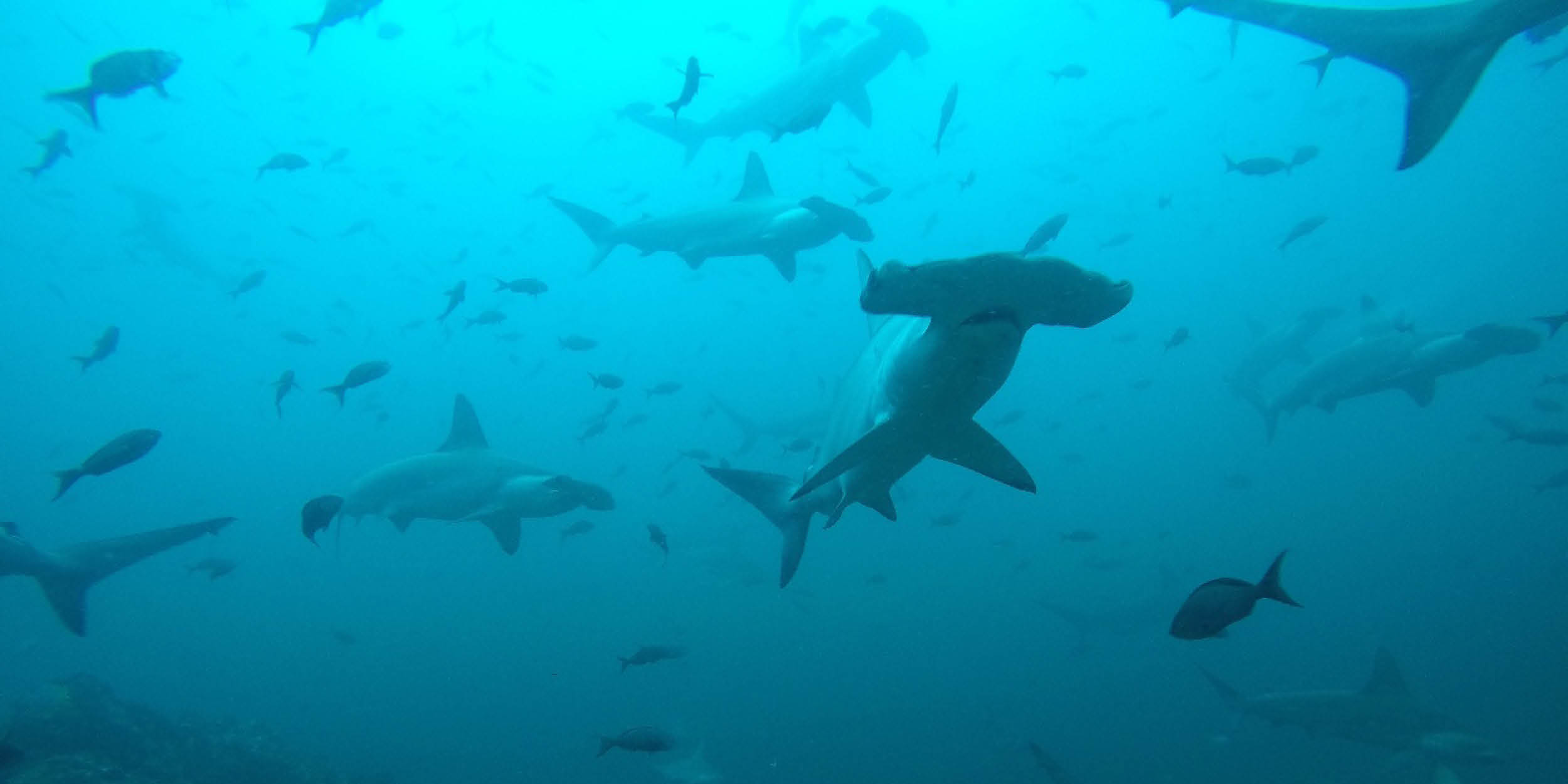
Recent studies have demonstrated that sharks and turtles use the swimway to migrate between the marine reserves, putting them at grave risk to industrial fishing.
New research demonstrates the importance of ‘swimways’ in securing the protection of marine endangered species
COSTA RICA—A new, multi-institutional study reveals the importance and limitations of current marine protected areas in securing protections for highly migratory endangered marine species.
The study, “Movements of scalloped hammerhead sharks (Sphyrna lewini) at Cocos Island, Costa Rica and between oceanic islands in the Eastern Tropical Pacific,” tracked endangered hammerhead sharks with acoustic tags in the Eastern Tropical Pacific region.
“Some hammerhead sharks showed a strong residency to Cocos Island, but our research also indicates that these sharks migrate between the protected hotspots at oceanic islands, moving through the open ocean where there is little or no protection from commercial fishing operations,” said Elena Nalesso, who published the research as part of her master’s thesis at the Ensenada Center for Scientific Research and Higher Education.
Nalesso and her co-authors, a group of scientists based throughout the Eastern Tropical Pacific, studied the movements of hammerhead sharks within Cocos Island marine protected area and between Cocos Island National Park (Costa Rica), Galapagos National Park (Ecuador) and Malpelo Nature Reserve (Colombia). The study is part of a regional initiative, known as MigraMar, to understand the movement behavior of endangered marine migratory species with respect to marine reserves.
“The implications for management and conservation of this research indicates that protecting oceanic hotspots is critical but insufficient for the protection of hammerheads,” said Dr. Alex Hearn, professor and researcher at the Galapagos Science Center, Universidad San Francisco de Quito, Ecuador, and one of Nalesso’s research supervisors. “Conservation efforts must also include protecting their migratory routes if we are to recover these endangered species.”
Turtle Island Restoration Network Executive Director Todd Steiner, who co-authored the study, said to secure the protection of highly migratory species, we need new conservation tools, such as creating the first known bilateral marine protected area, known as the Cocos-Galapagos Swimway.
“Highly migratory species have complicated life-histories and require more protection than they receive from simply protecting them at a single place in one country,” Steiner said.
The Cocos-Galapagos Swimway is an area of ocean rich in biodiversity, measuring approximately 120,000 square kilometers, that follows the Cocos Ridge, an underwater mountain range that links the Galapagos and Cocos Marine Reserves. Recent studies have demonstrated that sharks and turtles use the swimway to migrate between the marine reserves, putting them at grave risk to industrial fishing.
MigraMar, along with its partners Costa Rica Forever, Pacifico, and others from the region, have already met with government officials from Ecuador and Costa Rica to map out a path to a bilateral agreement that will protect at least five endangered species who migrate thousands of miles between oceanic hotspot marine protected areas. It would be the world’s first marine protected area between two sovereign nations.
“We are committed to continue this 14-year research project and provide the Costa Rican authorities with the best information possible in order to expand the marine protected area surrounding Cocos Island,” said Randall Arauz, Marine Conservation Policy Advisor of Fins Attached Marine Research and Conservation.
The study was published in PLOS One, an open-access scientific journal published by the Public Library of Science since 2006. All co-authors include Elena Nalesso 1,2, Alex Hearn, 3,4, 5, Oscar Sosa-Nishizaki1, Todd SteinerID4,5, Alex Antoniou6, Andrew ReidID7, Sandra Bessudo5,8, Germa ́n Soler5,8,9, A. Peter Klimley5,10, Frida Lara5,11, James T. Ketchum5,11, Randall Arauz2,5
1 Department of Biological Oceanography, Centro de Investigación Científica y de Educación Superior de Ensenada, Ensenada, Baja California, México,
2 Programa Restauración de Tortugas Marinas, San Jose ́, Costa Rica,
3 Colegio de Ciencias Biológicas y Ambientales / Galapagos Science Center, Universidad San Francisco de Quito, Quito, Ecuador,
4 Turtle Island Restoration Network, Forest Knolls, California, United States of America,
5 MigraMar, Forest Knolls, California, United States of America,
6 Fins Attached Marine Research and Conservation, Colorado Springs, Colorado, United States of America,
7 Jurassic Shark Expeditions, Dorchester,United Kingdom,
8 Fundación Malpelo y Otros Ecosistemas Marinos, Bogotá, Colombia,
9 Institute of Marine and Antarctic Studies, University of Tasmania, Tasmania, Australia,
10 Department of Wildlife, Fish & Conservation Biology, University of California, Davis, California, United States of America,
11 Pelagios Kakunjá A.C., La Paz, Baja California Sur, México.
###
Turtle Island Restoration Network is a leading advocate for the world’s oceans and marine wildlife that conducts shark migration research for MigraMar with the help of citizen scientists who join liveaboard dive expeditions to Cocos Island. If you are interested in joining our research, please visit www.seaturtles.org/cocos.
Press Contacts:
Todd Steiner, tsteiner@seaturtles.org
Turtle Island Restoration Network Executive Director
Randall Arauz, rarauz@finsattached.org
Fins Attached Marine Research and Conservation Marine Conservation Policy Advisor
Rosario Alvarez, rosario.alvarez@migramar.org
MigraMar Executive Director




